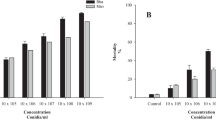Abstract
In 1973, Dipel® (Bacillus thuringiensis Berliner) and Sevin® 4 oil (carbaryl) were applied aerially on a dense population of gypsy moths,Lymantria dispar (L.), to evaluate the effect of these biological and chemical insecticides on gypsy moth larvae and adult parasites. Both insecticides provided excellent protection of foliage (29 % average defoliation) and gypsy moth population reduction (99 %). Significantly fewerBrachymeria intermedia (Nees), andApanteles melanoscelus (Ratzeburg),Parasetigena silvestris (Robineau-Desvoidy) andCompsilura concinnata (Meigen) adult parasites were captured in the blocks treated with Sevin 4 oil or Dipel than in the control block during the treatment year and in 1974, respectively.
Résumé
En 1973, du Dipel® (Bacillus thuringiensis Berliner) et du Sevin® 4 huileux (carbaryl) furent appliqués par voie aérienne sur des populations denses deLymantria dispar (L.) pour déterminer l’effet de ces insecticides biologiques et chimiques sur les larves de ce ravageur et sur ses parasites adultes. Les 2 insecticides assurèrent une excellente protection du feuillage (29 % en moyenne de défeuillaison) et une très bonne réduction (99 %) de la population deL. dispar. Les captures d’adultes deBrachymeria intermedia (Nees),Apanteles melanoscelus (Ratzeburg),Parasetigena silvestris (Robineau-Desvoidy) etCompsilura concinnata (Meigen) furent significativement moins nombreuses dans les parcelles traitées au Sevin ou au Dipel que dans les parcelles témoins l’année du traitement et en 1974, respectivement.
Similar content being viewed by others
References
Ahmad, S. &Forgash, A. — 1976. Toxicity of carbaryl to gypsy moth larvae parasitized byApanteles melanoscelus. —Environ. Entomol., 5, 1183–1186.
Doane, C. & Schaefer, P. — 1971. Aerial application of insecticides for control of the gypsy moth. —Conn. Agric. Exp. Stn. Bull., 724, 23 pp.
Dowden, P. B. — 1961. The persistence of gypsy moth parasites in heavily sprayed areas on Cape Cod, Mass. —J. Econ. Entomol., 54, 873–875.
Dunbar, D., Kaya, H., Doane, C., Anderson, J. & Weseloh, R. — 1973. Aerial application ofBacillus thuringiensis against larvae of the elm spanworm and gypsy moth and effects on parasitoids of the gypsy moth. —Conn. Agric. Exp. Stn. Bull., 735, 23 pp.
Herting, B. — 1969. Tent window traps used for collecting tachinids [Dipt.] at Delemont, Switzerland. —Commonw. Inst. Biol. Control Tech. Bull., 12, 1–19.
McPhail, M. — 1943. Linseed oil soap: A new lure for the melon fly. —J. Econ. Entomol., 36, 426–429.
Reardon, R. — 1976. Parasite incidence and ecological relationships in field populations of gypsy moth larvae and pupae. —Environ. Entomol., 5, 981–987.
Sellmer, G. & Snygg, J. — 1973. An evaluation of the effect and environment impact of Carbaryl (Sevin-4-oil) on populations of three hymenopteran parasitoids of the gypsy moth in New Jersey. —Upsala Col. Rep., 49 pp.
Townes, H. K. — 1972. A light-weight Malaise trap. —Entomol. News, 83, 239–247.
Author information
Authors and Affiliations
Additional information
The work herein reported was funded in part by a U.S.D.A. sponsored program entitled “The Expanded Gypsy Moth Research and Application Program” Northeastern Area, State and Private Forestry, Cooperative Agreement 42–160.
Rights and permissions
About this article
Cite this article
Reardon, R., Metterhouse, W. & Balaam, R. Impact of aerially appliedBacillus thuringiensis and carbaryl on gypsy moth [Lep.: Lymantriidae] and adult parasites. Entomophaga 24, 305–310 (1979). https://doi.org/10.1007/BF02374245
Issue Date:
DOI: https://doi.org/10.1007/BF02374245




